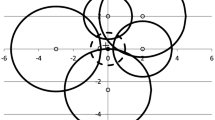Abstract
In this paper, we consider the multiple facility location problem with gradual cover. Gradual cover means that up to a certain distance from the facility a demand point is fully covered. Beyond another distance the demand point is not covered at all. Between these two distances the demand point is partially covered. When there are \(p\) facilities, the cover of each demand point can be calculated by a given formula. One objective in this setting is to find locations for \(p\) facilities that maximize the total cover. In this paper we consider another objective of maximizing the minimum cover of every demand point. This guarantees that every demand point is covered as much as possible and there are no demand points with low cover. The model is formulated and heuristic algorithms are proposed for its solution. We solved a real-life problem of locating cell phone towers in northern Orange County, California and demonstrated the solution approach on a set of 40 test problems.



Similar content being viewed by others
References
Abramowitz M, Stegun I (1972) Handbook of mathematical functions. Dover Publications Inc., New York
Alp O, Drezner Z, Erkut E (2003) An efficient genetic algorithm for the \(p\)-median problem. Ann Oper Res 122:21–42
Beasley JE (1990) OR-library—distributing test problems by electronic mail. J Oper Res Soc 41:1069–1072. http://people.brunel.ac.uk/~mastjjb/jeb/orlib/pmedinfo.html
Berman O, Krass D (2002) The generalized maximal covering location problem. Comput Oper Res 29:563–591
Berman O, Drezner Z, Wesolowsky G (2003a) Locating service facilities whose reliability is distance dependent. Comput Oper Res 30:1683–1695
Berman O, Krass D, Drezner Z (2003b) The gradual covering decay location problem on a network. Eur J Oper Res 151:474–480
Berman O, Drezner Z, Wesolowsky GO (2009) The maximal covering problem with some negative weights. Geogr Anal 41:30–42
Berman O, Drezner Z, Krass D (2010a) Cooperative cover location problems: the planar case. IIE Trans 42:232–246
Berman O, Drezner Z, Krass D (2010b) Generalized coverage: New developments in covering location models. Comput Oper Res 37:1675–1687
Berman O, Drezner Z, Krass D (2014) The multiple gradual cover location problem (in preparation)
Chen D, Chen R (2009) New relaxation-based algorithms for the optimal solution of the continuous and discrete p-center problems. Comput Oper Res 36:1646–1655
Church RL, ReVelle CS (1974) The maximal covering location problem. Papers Region Sci Assoc 32:101–118
Church RL, Roberts KL (1984) Generalized coverage models and public facility location. Papers Region Sci Assoc 53:117–135
Current J, Daskin M, Schilling D (2002) Discrete network location models. In: Drezner Z, Hamacher HW (eds) Facility location: applications and theory. Springer, Berlin, pp 81–118
Drezner Z (1992) Computation of the multivariate normal integral. ACM Trans Math Softw 18:470–480
Drezner T (2004) Location of casualty collection points. Environ Plan C Gov Policy 22:899–912
Drezner Z (2010) Random selection from a stream of events. Commun ACM 53:158–159
Drezner Z, Wesolowsky GO (1990) On the computation of the bivariate normal integral. J Stat Comput Simul 35:101–107
Drezner Z, Wesolowsky G (1997) On the best location of signal detectors. IIE Trans 29:1007–1015
Drezner T, Drezner Z (2007) Equity models in planar location. Computat Manage Sci 4:1–16
Drezner T, Drezner Z (2008) Lost demand in a competitive environment. J Oper Res Soc 59:362–371
Drezner Z, Marcoulides GA (2009) On the range of tabu tenure in solving quadratic assignment problems. Recent advances in computing and management information systems. Athens Institute for Education and Research, Athens, Greece, pp 157–168
Drezner Z, Wesolowsky GO, Drezner T (2004) The gradual covering problem. Naval Res Logist 51:841–855
Drezner T, Drezner Z, Guyse J (2009) Equitable service by a facility: minimizing the Gini coefficient. Comput Oper Res 36:3240–3246
Drezner T, Drezner Z, Goldstein Z (2010) A stochastic gradual cover location problem. Naval Res Logist 57:367–372
Eiselt HA, Laporte G (1995) Objectives in location problems. In: Drezner Z (ed) Facility location: a survey of applications and methods. Springer, New York, pp 151–180
Eiselt HA, Marianov V (2009) Gradual location set covering with service quality. Socio-Econom Plan Sci 43:121–130
Erkut E (1993) Inequality measures for location problems. Locat Sci 1:199–217
Glover F (1977) Heuristics for integer programming using surrogate constraints. Decis Sci 8:156–166
Glover F (1986) Future paths for integer programming and links to artificial intelligence. Comput Oper Res 13:533–549
Glover F, Laguna M (1997) Tabu search. Kluwer, Boston
Johnson NL, Kotz S (1972) Dlstributions in statistics: continuous multivariate distributions. Wiley, New York
Karasakal O, Karasakal E (2004) A maximal covering location model in the presence of partial coverage. Comput Oper Res 31:15–26
Kariv O, Hakimi SL (1979) An algorithmic approach to network location problems. I: the p-centers. SIAM J Appl Math 37:513–538
Kolen A, Tamir A (1990) Covering problems. In: Mirchandani PB, Francis RL (eds) Discrete location theory. Wiley, New York, pp 263–304
Marianov V, Eiselt HA (2012) Transmitter location for maximum coverage and constructivedestructive interference management. Comput Oper Res 39:1441–1449
Marsh M, Schilling D (1994) Equity measurement in facility location analysis: a review and framework. Eur J Oper Res 74:1–17
Mulligan GF (1991) Equity measures and facility location. Papers Region Sci 70:345–365
Plastria F (1995) Continuous location problems: research, results and questions. In: Drezner Z (ed) Facility location: a survey of applications and methods. Springer, Berlin, pp 85–127
Plastria F (2002) Continuous covering location problems. In: Drezner Z, Hamacher HW (eds) Facility location: applications and theory. Springer, Berlin, pp 37–79
Steck GP (1962) Orthant probabilities for the equicorrelated multivariate normal distribution. Biometrika 49:433–445
Author information
Authors and Affiliations
Corresponding author
Rights and permissions
About this article
Cite this article
Drezner, T., Drezner, Z. The maximin gradual cover location problem. OR Spectrum 36, 903–921 (2014). https://doi.org/10.1007/s00291-013-0350-7
Published:
Issue Date:
DOI: https://doi.org/10.1007/s00291-013-0350-7




